Exploration of Extension Research to Promote Genetic Improvement in Cattle Production: Systematic Review
Abstract
Simple Summary
Abstract
1. Introduction
2. Materials and Methods
2.1. Search Strategy
2.2. Document Selection
3. Results and Discussion
3.1. Location, Farmer Profile and Cattle Livestock
3.2. Methods and Frameworks
3.2.1. Attitudes toward Genetic and Breeding Tools
3.2.2. Preferences of Genetic Traits
3.3. Adoption Factors of Genetic Tools
3.4. Impact on Genetic Improvements Programs
4. Conclusions
Supplementary Materials
Author Contributions
Funding
Institutional Review Board Statement
Informed Consent Statement
Data Availability Statement
Conflicts of Interest
References
- Banks, R. Evolution of Genetics Organisations’ Strategies through the Implementation of Genomic Selection: Learnings and Prospects. Agriculture 2022, 12, 1524. [Google Scholar] [CrossRef]
- Bell, A.W. Animal science down Under: A history of research, development and extension in support of Australia’s livestock industries. Anim. Prod. Sci. 2019, 60, 193–231. [Google Scholar] [CrossRef]
- Weigel, K.A.; VanRaden, P.M.; Norman, H.D.; Grosu, H. A 100-Year Review: Methods and impact of genetic selection in dairy cattle—From daughter–dam comparisons to deep learning algorithms. J. Dairy Sci. 2017, 100, 10234–10250. [Google Scholar] [CrossRef]
- Hayes, B.J.; Lewin, H.A.; Goddard, M.E. The future of livestock breeding: Genomic selection for efficiency, reduced emissions intensity, and adaptation. Trends Genet. 2013, 29, 206–214. [Google Scholar] [CrossRef]
- Cole, J.B.; VanRaden, P.M. Symposium review: Possibilities in an age of genomics: The future of selection indices. J. Dairy Sci. 2018, 101, 3686–3701. [Google Scholar] [CrossRef]
- Meat & Livestock Australia. Final Report P.PSH.0833: Accelerating Genetic Gain for Productivity and Profitability in Northern Beef Cattle with Genomic Technologies; Meat and Livestock Australia Limited: Sydney, Australia, 2022. [Google Scholar]
- Pannell, D.J.; Vanclay, F. Changing Land Management: Adoption of New Practices by Rural Landholders; CSIRO Publishing: Victoria, Australia, 2011. [Google Scholar]
- Montes de Oca Munguia, O.; Pannell, D.J.; Llewellyn, R.; Stahlmann-Brown, P. Adoption pathway analysis: Representing the dynamics and diversity of adoption for agricultural practices. Agric. Syst. 2021, 191, 103173. [Google Scholar] [CrossRef]
- Sun, D.; Hyland, P.; Bosch, O. A Systemic View of Innovation Adoption in the Australian Beef Industry. Syst. Res. Behav. Sci. 2015, 32, 646–657. [Google Scholar] [CrossRef]
- Montes de Oca Munguia, O.; Pannell, D.J.; Llewellyn, R. Understanding the Adoption of Innovations in Agriculture: A Review of Selected Conceptual Models. Agronomy 2021, 11, 139. [Google Scholar] [CrossRef]
- Taherdoost, H. A review of technology acceptance and adoption models and theories. Procedia Manuf. 2018, 22, 960–967. [Google Scholar] [CrossRef]
- Devitt, S.K. Cognitive factors that affect the adoption of autonomous agriculture. arXiv 2021, arXiv:2111.14092. [Google Scholar]
- Martin-Collado, D.; Byrne, T.J.; Diaz, C.; Amer, P.R. Complexity of animal breeding choice making. J. Anim. Breed. Genet. 2018, 135, 395–409. [Google Scholar] [CrossRef] [PubMed]
- Nielsen, H.M.; Amer, P.R.; Byrne, T.J. Approaches to formulating practical breeding objectives for animal production systems. Acta Agric. Scand. Sect. A—Anim. Sci. 2013, 64, 2–12. [Google Scholar] [CrossRef]
- Nettle, R.; Major, J.; Turner, L.; Harris, J. Selecting methods of agricultural extension to support diverse adoption pathways: A review and case studies. Anim. Prod. Sci. 2022, 64, AN22329. [Google Scholar] [CrossRef]
- Marsh, S.P.; Pannell, D. Agricultural extension policy in Australia: The good, the bad and the misguided. Aust. J. Agric. Resour. Econ. 2002, 44, 605–627. [Google Scholar] [CrossRef]
- Dill, M.D.; Emvalomatis, G.; Saatkamp, H.; Rossi, J.A.; Pereira, G.R.; Barcellos, J.O.J. Factors affecting adoption of economic management practices in beef cattle production in Rio Grande do Sul state, Brazil. J. Rural Stud. 2015, 42, 21–28. [Google Scholar] [CrossRef]
- Gebre, Y.H.; Gebru, G.W.; Gebre, K.T. Adoption of artificial insemination technology and its intensity of use in Eastern Tigray National Regional State of Ethiopia. Agric. Food Secur. 2022, 11, 44. [Google Scholar] [CrossRef]
- Quddus, M.A. Dissemination of Technological Innovations of Livestock in Bangladesh: Adoption Levels and Behavioral Precision. Proc. Natl. Acad. Sci. India Sect. B Biol. Sci. 2022, 92, 461–472. [Google Scholar] [CrossRef]
- Manning, J.; Power, D.; Cosby, A. Legal Complexities of Animal Welfare in Australia: Do On-Animal Sensors Offer a Future Option? Animals 2021, 11, 91. [Google Scholar] [CrossRef]
- Cosby, A.M.; Fogarty, E.S.; Power, D.A.; Manning, J.K. Chapter 22: Data, decision-making and demand: The importance of education and training opportunities with precision livestock farming technologies for Australian producers. In Practical Precision Livestock Farming: Hands-on Experiences with PLF Technologies in Commercial and R&D Settings; Wageningen Academic: Leiden, The Netherlands, 2023; pp. 397–417. [Google Scholar] [CrossRef]
- Page, M.J.; McKenzie, J.E.; Bossuyt, P.M.; Boutron, I.; Hoffmann, T.C.; Mulrow, C.D.; Shamseer, L.; Tetzlaff, J.M.; Akl, E.A.; Brennan, S.E.; et al. The PRISMA 2020 statement: An updated guideline for reporting systematic reviews. Int. J. Surg. 2021, 88, 105906. [Google Scholar] [CrossRef]
- HLPE. Investing in Smallholder Agriculture for Food Security. A Report by the High Level Panel of Experts on Food Security and Nutrition of the Committee on World Food Security, Rome; High Level Panel of Experts on Food Security and Nutrition (HLPE-FSN): Rome, Italy, 2013; p. 112. [Google Scholar]
- Zoma-Traoré, B.; Probst, L.; Ouédraogo-Koné, S.; Soudré, A.; Ouédraogo, D.; Yougbaré, B.; Traoré, A.; Khayatzadeh, N.; Mészáros, G.; Burger, P.A.; et al. Livestock keepers’ attitudes: Keystone of effective community-based breeding programs. Sustainability 2021, 13, 2499. [Google Scholar] [CrossRef]
- Traoré, S.A.; Markemann, A.; Reiber, C.; Piepho, H.P.; Valle Zárate, A. Production objectives, trait and breed preferences of farmers keeping N’Dama, Fulani Zebu and crossbred cattle and implications for breeding programs. Animal 2017, 11, 687. [Google Scholar] [CrossRef]
- Hatew, B.; Peñagaricano, F.; Balehegn, M.; Jones, C.S.; Dahl, G.E.; Adesogan, A.T. Synergies of feed, management trainings, and genetics on milk production of dairy cows in the tropics: The case of Ethiopian smallholder farmers. Front. Anim. Sci. 2023, 4, 1119786. [Google Scholar] [CrossRef]
- Camara, Y.; Moula, N.; Sow, F.; Sissokho, M.M.; Antoine-Moussiaux, N. Analysing innovations among cattle smallholders to evaluate the adequacy of breeding programs. Animal 2019, 13, 417–426. [Google Scholar] [CrossRef]
- Vasquez, H.V.; Barrantes-Bravo, C.A.; Vigo, C.N.; Maicelo-Quintana, J.L. Socioeconomic factors that influence technology adoption for genetic improvement of cattle in Peru. Agric. Soc. Desarro. 2022, 19, 312–330. [Google Scholar] [CrossRef]
- Bottani-Claros, G.; Jonas, E.; Strandberg, E. Relevance of the production system for the sustainability of conservation and breeding programs for the Creole cattle in Pasorapa, Bolivia. Discov. Sustain. 2022, 3, 19. [Google Scholar] [CrossRef]
- Yakubu, A.; Dahloum, L.; Gimba, E.G. Smallholder cattle farmers’ breeding practices and trait preferences in a tropical Guinea savanna agro-ecological zone. Trop. Anim. Health Prod. 2019, 51, 1497–1506. [Google Scholar] [CrossRef]
- Roessler, R. Selection Decisions and Trait Preferences for Local and Imported Cattle and Sheep Breeds in Peri-/Urban Livestock Production Systems in Ouagadougou, Burkina Faso. Animals 2019, 9, 207. [Google Scholar] [CrossRef]
- Gordo, J.M.L.; da Silva, M.C.; Solano, G.D.; Lopes, F.B.; Costa, M.; Rocha, F.E.D.; Fioravanti, M.C.S.; Sereno, J.R.B. Cattle farmers: Profile and speech content analysis while undergoing training to adopt artificial insemination in Goias State, Brazil. Rev. Bras. Zootecn. 2013, 42, 162–167. [Google Scholar] [CrossRef][Green Version]
- González, J.M.S.; Rodríguez, J.A.L.; Myriam Sagarnaga Villegas, L.; Zavala-Pineda, M.J. Technology adoption by producers participating in the livestock productivity enhancement scheme (PROGAN) in Mexico. Rev. Mex. Cienc. Pecu. 2013, 4, 243–254. [Google Scholar]
- Marshall, K.; Mtimet, N.; Wanyoike, F.; Ndiwa, N.; Ghebremariam, H.; Mugunieri, L.; Costagli, R. Traditional livestock breeding practices of men and women Somali pastoralists: Trait preferences and selection of breeding animals. J. Anim. Breed. Genet. 2016, 133, 534–547. [Google Scholar] [CrossRef]
- Sirajuddin, S.N.; Sudirman, I.; Bahar, L.D.; Al Tawaha, A.R.; Al-Tawaha, A.R. Social economic factors that affect cattle farmer’s willingness to pay for artificial insemination programs. Bulg. J. Agric. Sci. 2018, 24, 574–580. [Google Scholar]
- Martin-Collado, D.; Díaz, C.; Benito-Ruiz, G.; Ondé, D.; Rubio, A.; Byrne, T.J. Measuring farmers’ attitude towards breeding tools: The Livestock Breeding Attitude Scale. Animal 2021, 15, 100062. [Google Scholar] [CrossRef] [PubMed]
- Pereira, J.M.V.; Bruno, D.; Marcondes, M.I.; Ferreira, F.C. Use of Beef Semen on Dairy Farms: A Cross-Sectional Study on Attitudes of Farmer Toward Breeding Strategies. Front. Anim. Sci. 2022, 2, 785253. [Google Scholar] [CrossRef]
- Ooi, E.; Stevenson, M.A.; Beggs, D.S.; Mansell, P.D.; Pryce, J.E.; Murray, A.; Pyman, M.F. Herd manager attitudes and intentions regarding the selection of high-fertility EBV sires in Australia. J. Dairy Sci. 2021, 104, 4375–4389. [Google Scholar] [CrossRef] [PubMed]
- Clasen, J.B.; Bengtsson, C.; Kallstrom, H.N.; Strandberg, E.; Fikse, W.F.; Rydhmer, L. Dairy cattle farmers’ preferences for different breeding tools. Animal 2021, 15, 100409. [Google Scholar] [CrossRef]
- Martin-Collado, D.; Byrne, T.J.; Amer, P.R.; Santos, B.F.S.; Axford, M.; Pryce, J.E. Analyzing the heterogeneity of farmers’ preferences for improvements in dairy cow traits using farmer typologies. J. Dairy Sci. 2015, 98, 4148–4161. [Google Scholar] [CrossRef]
- Lund, T.B.; Gamborg, C.; Secher, J.; Sandoe, P. Danish dairy farmers’ acceptance of and willingness to use semen from bulls produced by means of in vitro embryo production and genomic selection. J. Dairy Sci. 2021, 104, 8023–8038. [Google Scholar] [CrossRef] [PubMed]
- Chagunda, M.G.G.; Mujibi, F.D.N.; Dusingizimana, T.; Kamana, O.; Cheruiyot, E.; Mwai, O.A. Use of high density single nucleotide polymorphism (SNP) arrays to assess genetic diversity and population structure of dairy cattle in smallholder dairy systems: The case of Girinka Programme in Rwanda. Front. Genet. 2018, 9, 438. [Google Scholar] [CrossRef]
- Camara, Y.; Sow, F.; Govoeyi, B.; Moula, N.; Sissokho, M.M.; Antoine-Moussiaux, N. Stakeholder involvement in cattle-breeding program in developing countries: A Delphi survey. Livest. Sci. 2019, 228, 127–135. [Google Scholar] [CrossRef]
- Anol, B. Social Science Research: Principles, Methods, and Practice. Textbooks Collection. 3. University of South Florida. 2012. Available online: https://digitalcommons.usf.edu/oa_textbooks/3 (accessed on 1 December 2023).
- Ajzen, I. The theory of planned behavior. Organ. Behav. Hum. Decis. Process. 1991, 50, 179–211. [Google Scholar] [CrossRef]
- Rogers, E.M. Diffusion of Innovations, 5th ed.; Free Press: New York, NY, USA, 2003. [Google Scholar]
- Montes Oca Munguia, O.; Llewellyn, R. The Adopters versus the Technology: Which Matters More when Predicting or Explaining Adoption? Appl. Econ. Perspect. Policy 2020, 42, 80–91. [Google Scholar] [CrossRef]
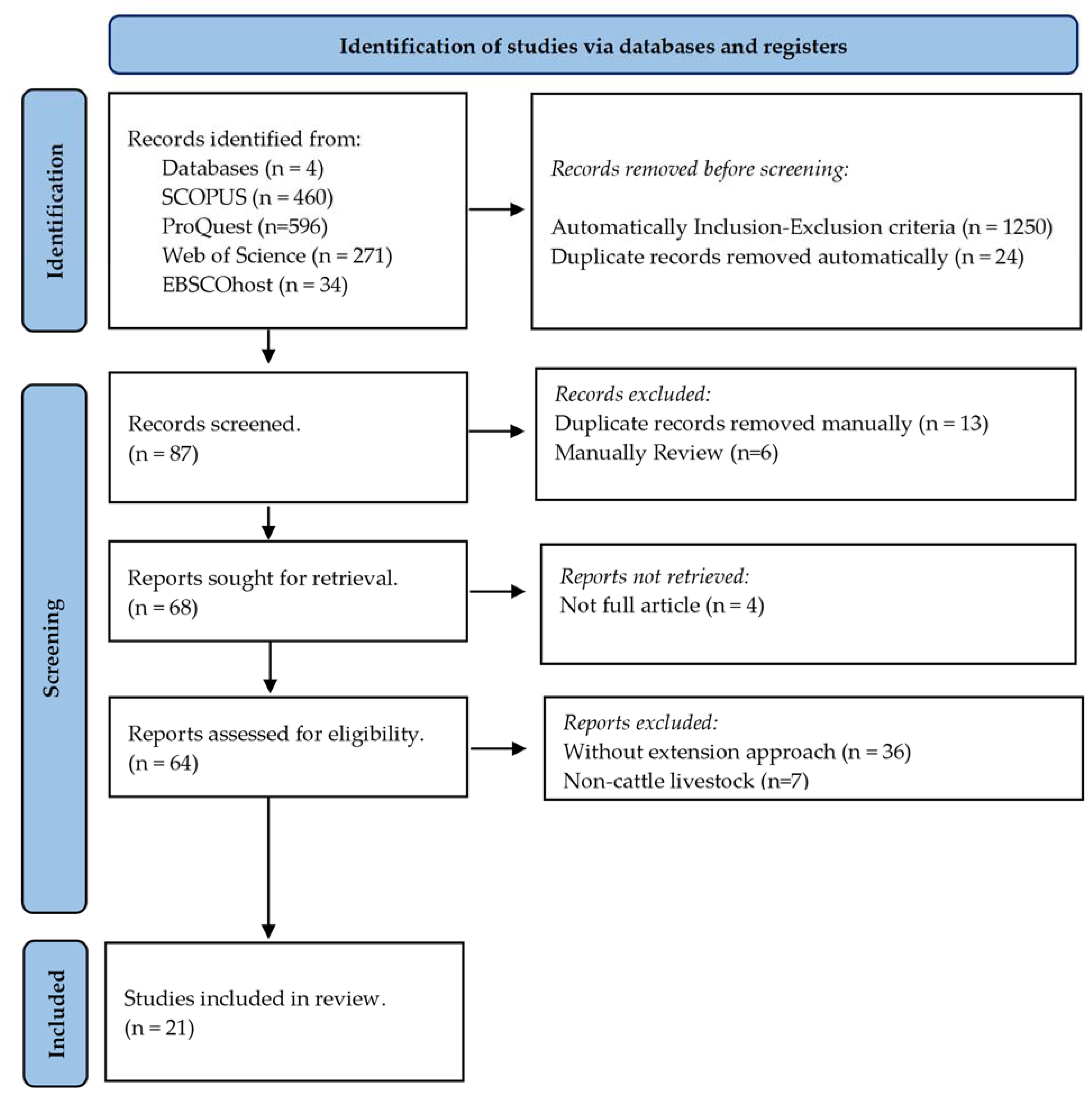
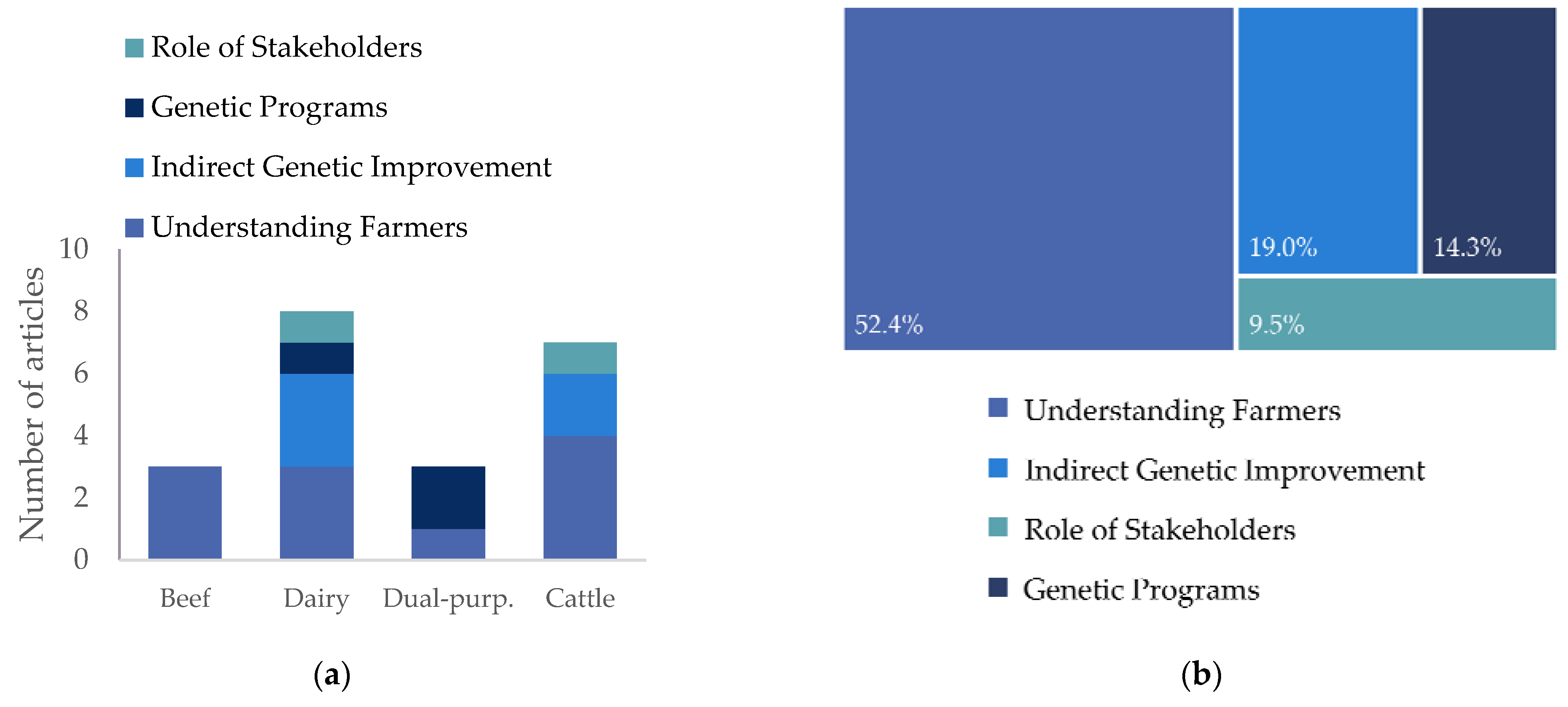
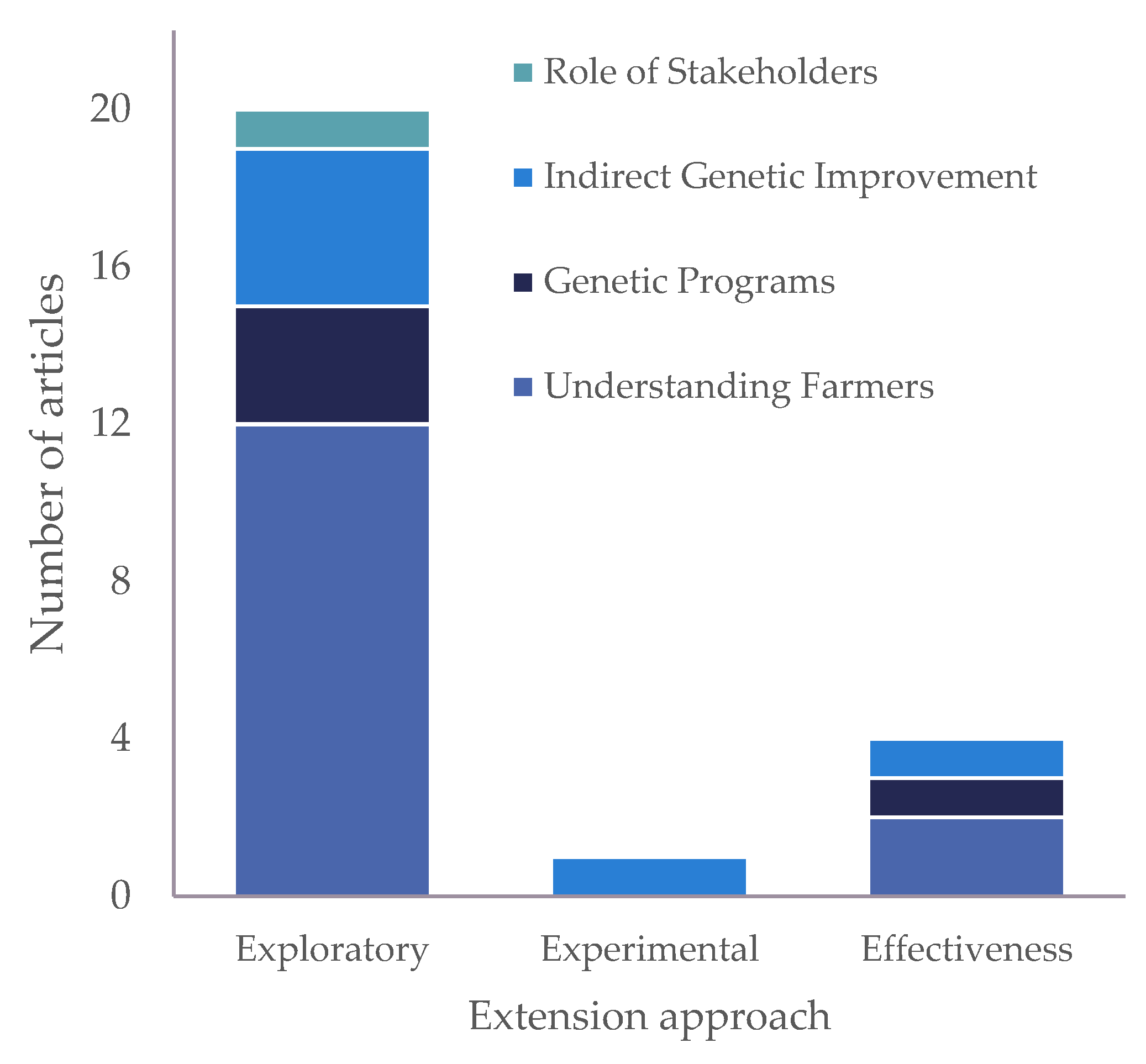
| Inclusion Criteria | Exclusion Criteria |
|---|---|
|
|
| Tools | Framework | Sampling (Sample Size) | Data Collection | Data Analysis | Reference |
|---|---|---|---|---|---|
| AI | NA | No probabilistic (n = 71) | Survey:
|
| [32] |
| Multistage technique: purposively, random and systematic (n = 204) | Farmer interview Focus group |
| [18] | ||
| (n = 85) | Cross sectional interview |
| [35] | ||
| AI Natural mating Purebred Crossbreeding | NA | Purposively, random (n = 227) | Data from database |
| [33] |
| AI Purebred Crossbreeding Recording data Appearance Sharing bull Benchmarking | NA | Purposively, stratified (n = 125) | Survey/Interview:
|
| [24] |
| AI Purebred Crossbreeding Appearance Recording data EBV DNA/gene data Benchmarking Embryo transfer | NA | Through breed associations (n = 328) | Survey:
|
| [36] |
| EBV | Theory of Panned Behavior | Purposively (n = 35) | Survey:
|
| [38] |
| EBV Selection Index | NA | Partly randomly (n = 551) | Survey farmer and farm profile |
| [40] |
| Sexed semen Beef semen Genomic testing Crossbreeding Embryo transfer | NA | (n = 204) | Survey
|
| [39] |
| Sexed semen Beef semen | NA | Partly random (n = 141) | Cross sectional survey |
| [37] |
| Genomic selection ovum pick-up In vitro production of embryos | Diffusion Theory | Purposively, stratified (n = 175) | Interview Survey |
| [41] |
| Selection tools | NA | Probabilistic and used stratified random sampling (n = 144) | Survey
|
| [28] |
| Traits | Sampling (Sample Size) | Data Collection | Data Analysis | Reference |
|---|---|---|---|---|
| Body size Coat color Conformation Crossbreeding Disease resistance Docility Fast growing calves Fertility Milk yield Traction ability | Purposively, representative of two farmer group (n = 160) | Focus group Interview | Descriptive statistics Exploded Logit Model | [25] |
| Adaptation Fat Milk production Meat production Milk production Reproductive performance | Purposively, random (n = 11) | Participatory rural appraisals | Descriptive statistics | [34] |
| Appearance Behavior Body size/growth Breed Coat color/pattern Dam’s milk yield Pedigree | Purposively, snowball (n = 49) | Interview | Descriptive statistics Analyses of variance | [31] |
| Buying bulls Calving difficulty Cow live weight Feed efficiency Fertility, longevity Lactation persistency Lameness Mammary system Mastitis resistance Milking speed Protein yield Temperament | Partly randomly (n = 551) | Survey:
| Descriptive statistics Pairwise comparison PCA and Cluster analysis Five-level Likert scale | [40] |
| Body conformation Body size Calving interval Disease resistance Heat tolerance Milk yield Survival | Purposively, random (n = 144) | Semi-structured interview | Chi-square (χ2) statistic Comparison | [30] |
| Technology/Practices | Measurements | Reference | |
|---|---|---|---|
| Attitudes | Breeding tools | Attitudinal statements in farming systems, farmer profile, farmer breeding strategies and breeding tools. | [24] |
| Attitudinal statements in traditional selection, genetic selection and economic selection. | [36] | ||
| Reproductive technologies and genomic selection | General acceptance, likelihood of use, self-reported lack of understanding, perceived utility and ethical reservations. | [41] | |
| Fertility EBV | Attitudes, subjective norms and perceived barriers. Land tenure, age, gender, input of concentrate feeding, breed, AI sire selection method, characteristic of herd management and breeding objectives. | [38] | |
| Preferences | Traits and Breeds | Household characteristics, herd composition, breeds, reasons for changing breeds and intended breed choice for the next 5 to 10 years. | [25] |
| Gender, productive objectives, perception on traits, criteria to selecting male breeding, age of selection and culling of female animals. | [34] | ||
| Age, household size, herd/flock size, gender, education level, ethnicity, main occupation, farm location, motivation to rising cattle or sheep, general breeding management, breed and traits preferences, selection criteria, culling decision and reasons. | [31] | ||
| Traits | Farmer and farm profile, farmer attitudes toward breeding tools and criteria to selecting bulls. | [40] | |
| Traits and Breeding practices | Sex, marital status, education, primary occupation, access to credit, personal saving, type of landholding, age, household size, family members, size of land, experience, knowledge of husbandry practices, ranking of production objectives and reason for keeping cattle. | [30] | |
| Breeding tools | Geographical location, production systems, number of cows, production level, breeding management, gender, age, education, role on the farm, breeding interest and choice of breeding tools. | [39] | |
| Farmer Profile | Selection tools | Characteristics of the producer, migration, characteristics of the herd, production system, level of organization, access to information and level of knowledge, economic characteristics of the producer, access to sources of financing and access to the market. | [28] |
| Breeding practices and other technologies | Income, adopted technologies, schooling, vegetation coverage, feeding indicators, animal health, genetics and management. | [33] |
| Dependant Variables | Independent Variables | Effect | |
|---|---|---|---|
| Tobit regression—Gebre et al. [18] | Marginal effect | ||
| AI rate | S | Literacy | 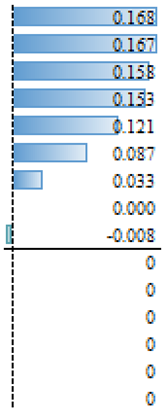 |
| Training | |||
| Feed supplementation practice | |||
| Access of the household to extension services | |||
| Mobile ownership | |||
| Number of cross breed cattle | |||
| Milk Yield | |||
| Income | |||
| Distance training center | |||
| N/S | Distance to AI service station | ||
| Gender | |||
| Age | |||
| Family size | |||
| Total farm size owned by the household | |||
| Total livestock holding in TLU | |||
| Linear Multiple regression—Sirajuddin et al. [35] | β | ||
| Willingness to pay AI program | S | Social awareness | 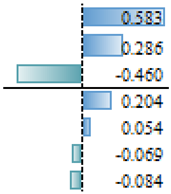 |
| Extension (counseling) | |||
| Location | |||
| N/S | Knowledge about AI | ||
| Education | |||
| Age | |||
| Business scale (herad) | |||
| Logistic regression—Vazques et al. [28] | Odd Ratio | ||
| Adoption of technologies for genetic improvement | S | Genetic improvement tools |  |
| Acces to finance | |||
| Genetic characteristics of animals | |||
| Credit Companies | |||
| N/S | Organizational level | ||
| Heads number | |||
| Educational level | |||
| Recognizes animal enhanced | |||
| Feeding | |||
| Livestock marketing | |||
| Livestock breeds | |||
| Milk production | |||
| Technical assistance | |||
| Technical assistance II | |||
| Area of land available for Livestock | |||
| Land tenure | |||
| Principal economy activity | |||
| Knowledge | |||
| Herd decision | |||
| Logistic regression—Pereira et al. [37] | Odd Ratio | ||
| Use of beef semen in dairy | S | Sexed dairy semen use |  |
| N/S | Region 2 | ||
| Herd breed | |||
| Herd size (>1500) | |||
| Herd size (501–1500) | |||
| Region 1 | |||
| Logistic regression—Pereira et al. [37] | Odd Ratio | ||
| Use of sexed dairy semen | S | Herd size (>1500) | 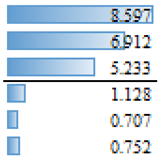 |
| Beef semen use | |||
| Herd size (501–1500) | |||
| N/S | Region 1 | ||
| Herd breed | |||
| Region 2 | |||
| Logit model (likelihood)—Lund et al. [41] | Coefficient | ||
| S | Perceived utility | 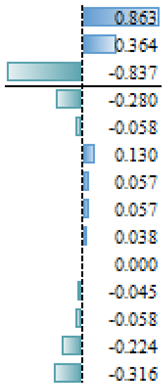 | |
| Use of the ovum pick-up–in vitro production of embryos–genomic selection technology | Frequency of use of NTM semen | ||
| Self-reported lack of understanding of the technology | |||
| N/S | Uses AI5 | ||
| Number of communications with breeding consultant | |||
| Age 40–59 yr (ref 20–39 yr) | |||
| Proportion of purebred cows genomically tested | |||
| Keep up with new breeding technologies | |||
| Uses sexed semen | |||
| Farm size (number of cows) | |||
| Oganic Farm (idealistic reasin) | |||
| Organic Farm | |||
| Age 60 yr or more (ref 20–39 yr) | |||
| Ethical reservations | |||
Disclaimer/Publisher’s Note: The statements, opinions and data contained in all publications are solely those of the individual author(s) and contributor(s) and not of MDPI and/or the editor(s). MDPI and/or the editor(s) disclaim responsibility for any injury to people or property resulting from any ideas, methods, instructions or products referred to in the content. |
© 2024 by the authors. Licensee MDPI, Basel, Switzerland. This article is an open access article distributed under the terms and conditions of the Creative Commons Attribution (CC BY) license (https://creativecommons.org/licenses/by/4.0/).
Share and Cite
Menchon, P.; Manning, J.K.; Swain, D.L.; Cosby, A. Exploration of Extension Research to Promote Genetic Improvement in Cattle Production: Systematic Review. Animals 2024, 14, 231. https://doi.org/10.3390/ani14020231
Menchon P, Manning JK, Swain DL, Cosby A. Exploration of Extension Research to Promote Genetic Improvement in Cattle Production: Systematic Review. Animals. 2024; 14(2):231. https://doi.org/10.3390/ani14020231
Chicago/Turabian StyleMenchon, Patricia, Jaime K. Manning, Dave L. Swain, and Amy Cosby. 2024. "Exploration of Extension Research to Promote Genetic Improvement in Cattle Production: Systematic Review" Animals 14, no. 2: 231. https://doi.org/10.3390/ani14020231
APA StyleMenchon, P., Manning, J. K., Swain, D. L., & Cosby, A. (2024). Exploration of Extension Research to Promote Genetic Improvement in Cattle Production: Systematic Review. Animals, 14(2), 231. https://doi.org/10.3390/ani14020231






